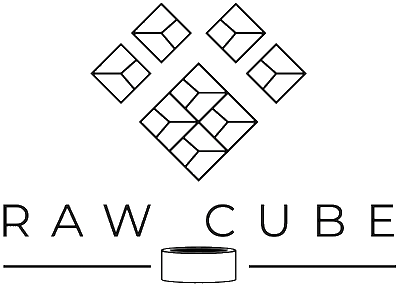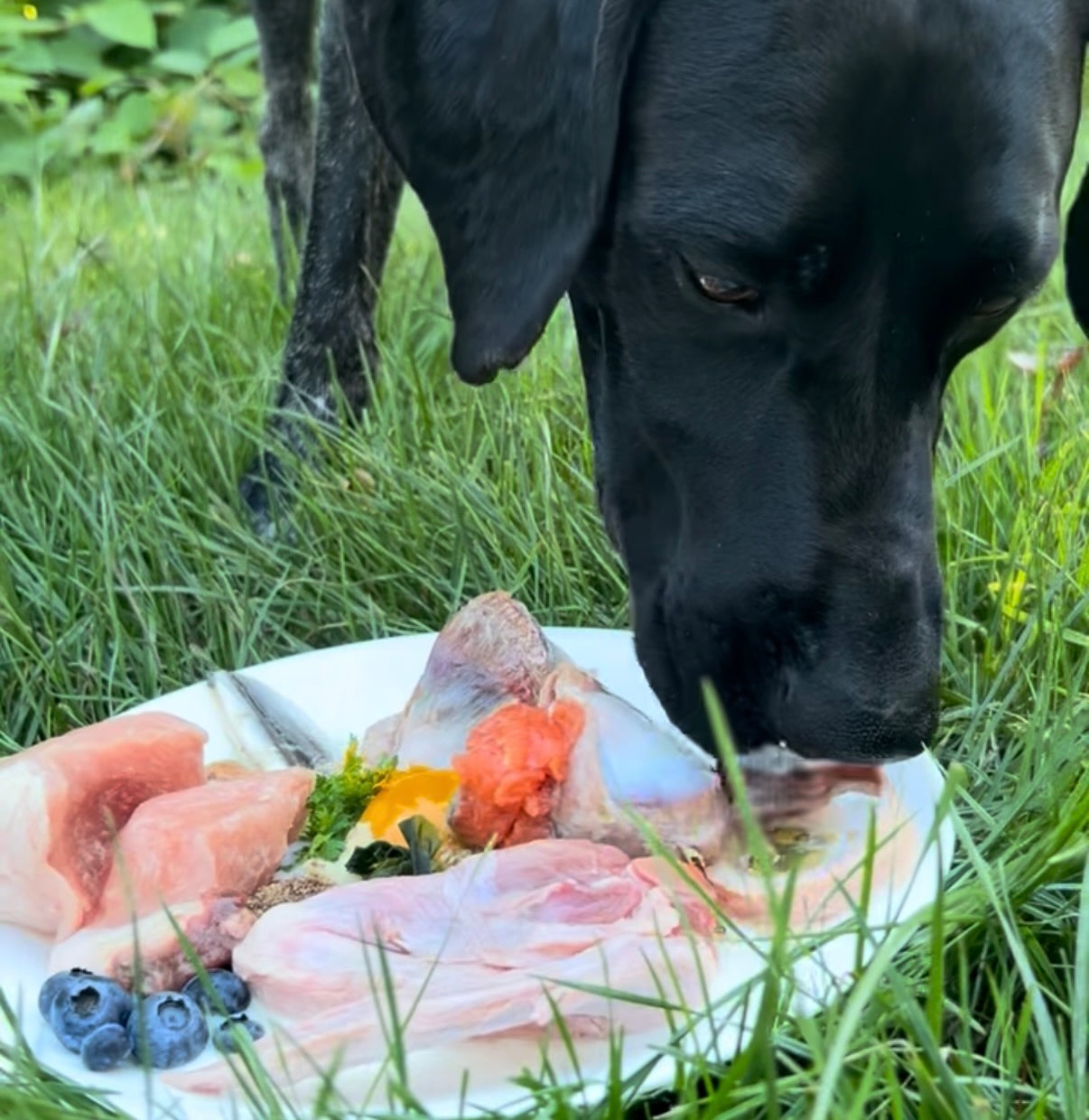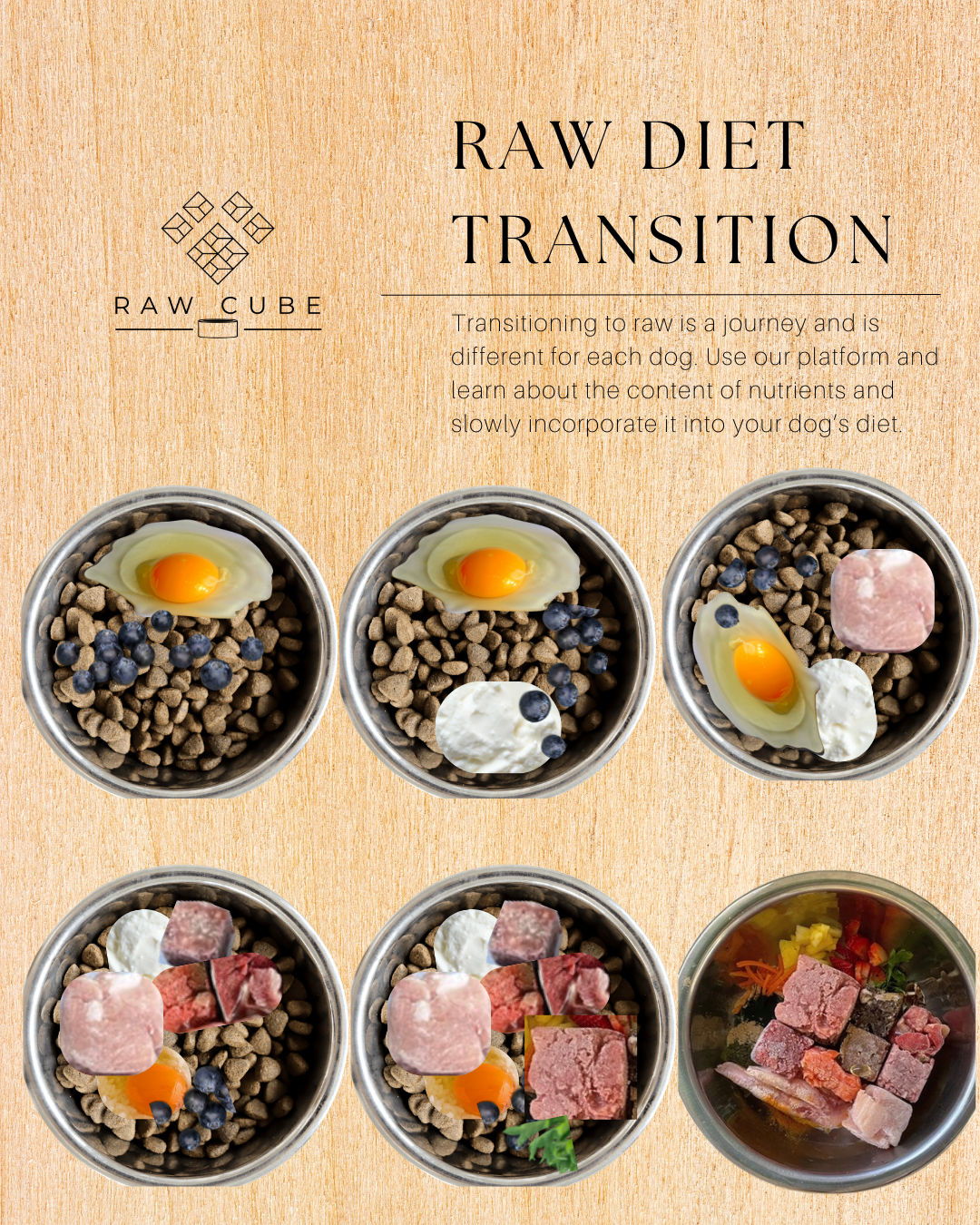
Common Nutrient Deficiencies and Toxicities in Raw Dog Food Diets
Feeding a raw dog food diet—whether you follow the BARF (Biologically Appropriate Raw Food) or Prey Model Raw (PMR) approach—can provide many benefits when done correctly. However, without careful planning, raw diets can lead to serious nutritional deficiencies and even toxicities that can impact your dog’s long-term health.
Understanding these risks is crucial for anyone considering raw feeding for dogs but before diving into the details, it’s important to remember that not every homemade or raw meal for your dog needs to be perfectly balanced on its own. What truly matters is that your dog receives all the essential nutrients over time, just as we do in our own diets.
Think about your typical day: you might start with cereal, grab a quick burrito or burger for lunch, and finish with a frozen meal from Trader Joe’s. Was every meal balanced? Probably not. Did you miss a few key nutrients that day? Most likely. But you’re still healthy and reading this article! The same principle applies to dogs—focus on variety and balance across the week, not perfection in every single bowl.
Common Nutrient Deficiencies in Raw Dog Food Diets
The following is not listed or presented in any particular order.
Calcium Deficiency
One of the most frequent problems in raw diets, especially those heavy on muscle meat but light on edible bone (or vice versa), is calcium deficiency or overconsumption of calcium. Dogs require the right balance of calcium and phosphorus for healthy bones and teeth. Without enough calcium (or excess of), dogs can develop impaired growth, spontaneous fractures, and loose teeth—especially puppies, who are most vulnerable to bone deformities and growth issues. One of the biggest challenges to understand (even to this day) is the percentage of bone in certain parts ie., chicken feet, turkey neck, duck wing.
Our favorite source to learn more about it : Perfectly Rawesome, Bone & Calcium Content in Raw Meaty Bones (RMB)
Zinc, Manganese, and Magnesium
Raw diets often lack adequate zinc, manganese, and magnesium, especially if not enough organ meats or specific whole foods are included. These minerals are vital for immune function, enzyme activity, and skeletal health. Deficiencies may result in poor skin, weak bones, and compromised immunity. We recommend supplementation or adding sources such as mussels, oysters, or kelp depending on their nutritional content.
For supplementation, here's an Amazon Link!
Vitamin D and Vitamin E
Both vitamin D and vitamin E are commonly low in raw diets, particularly if fatty fish or appropriate supplements aren’t regularly included. Vitamin D is essential for calcium absorption, while vitamin E acts as an antioxidant. Deficiency can lead to bone weakness and poor skin health. Something noteworthy to make is regardless of the supplementation you decide as a pet parent, consider researching about the bioavailability of the nutrient based on the form of supplementation.
Iodine
Iodine is often overlooked in homemade raw diets. Without sources like kelp, dogs can develop hypothyroidism and related metabolic issues. We love using human grade food so use japanese seaweed (dehydrated or hydrated is fine!)
Omega-3 Fatty Acids (EPA/DHA)
Most commercially farmed meats used in raw diets are high in omega-6 fatty acids but low in omega-3s, such as EPA and DHA which mainly come from fish/seafood. This imbalance can contribute to inflammation and poor skin and coat health unless fatty fish or fish oil is added. If you add salmon to your dog's diet (recommend wild salmon), you should be all set (make sure your salmon is previously frozen prior to feeding to kill any worms/parasites).
Iron and Thiamin
Deficiencies in iron (especially if red meat and spleen aren’t fed) and thiamin (vitamin B1) can also occur, leading to anemia and neurological issues. Taurine is another one for excessive freezing or sometimes evening grinding of meats.
Common Toxicities in Raw Dog Food Diets
Vitamin A Toxicity
Liver is a nutrient dense food which is why it's 5% for both BARF and PMR feeding models. Feeding large amounts of liver can lead to vitamin A toxicity. Signs include bone abnormalities, joint pain, and lethargy. Moderation is key: liver should make up only about 5% of the diet.
Calcium/Phosphorus Imbalance
Too much bone or calcium supplementation can result in a calcium-to-phosphorus ratio that is too high, leading to skeletal problems, especially in growing puppies.
Fat Overload
Some raw diets are excessively high in fat, which can cause obesity, pancreatitis, or mild anemia if not balanced with enough protein. Note that sometimes because the meats that are available to us are so lean, there can be a fat deficiency as well. Dry coats, crusty skin, are just two symptoms of this.
How to Prevent Deficiencies and Toxicities
-
Follow balanced, evidence-based recipes and consult with a veterinary nutritionist. For best source of information check out Perfectly Rawesome.
-
Rotate proteins and organ meats to provide a full spectrum of nutrients.
-
Include whole foods like fatty fish (for omega-3s and vitamin D), kelp (for iodine), and a variety of organs.
-
Limit liver to recommended amounts to avoid vitamin A toxicity.
-
Monitor your dog’s health for signs of deficiency (poor coat, weak bones, lethargy) or toxicity (joint pain, digestive upset).
- Supplementation is highly recommended for nutritional deficiencies. Often overlooked when looking at supplementation is bioavailability. Food sources (especially animal protein sources are the most bioavailable forms for dogs (rather than plant, or other forms). When looking at supplements make sure to research the most bioavailable option.
Resources:
-
Freeman, L. M., Chandler, M. L., Hamper, B. A., & Weeth, L. P. (2005). Raw food diets in companion animals: A critical review. Canadian Veterinary Journal, 46(6), 513–522.
- Davies, M., & Lawler, D. (2018). Raw diets for dogs and cats: a review, with particular reference to microbiological hazards. The Veterinary Record, 182(2), 50.
- Freeman, L. M., et al. (2013). Current knowledge about the risks and benefits of raw meat–based diets for dogs and cats. Journal of the American Veterinary Medical Association, 243(11), 1549-1558.
- Kim, S., Kim, J., & Jang, G. (2023). Nutritional evaluation of new alternative types of dog foods including raw and cooked homemade-style diets. Journal of Veterinary Science, 24(3), e37.


